Bac Ninh is not only famous for its four-body dresses associated with the image of brothers and sisters in sweet and earnest quan ho melodies. Coming to Kinh Bac land, visitors can also discover and admire beautiful and unique ceramic products at Phu Lang pottery village.
History of Phu Lang Pottery Village
Phu Lang Pottery Village is one of the famous traditional pottery villages in the country. Pottery village in Phu Lang commune, Que Vo district, Bac Ninh province, about 60 km from Hanoi. To visit the pottery village you can choose different means for your journey. From Hanoi, you can ride a motorbike along Highway 5 and then turn onto the new 1A road. At the roundabout over the bridge in Bac Ninh, turn right along the road to Pha Lai, then go down a small village road through Chau Cau market for about 5-10 minutes. In addition, visitors can also take bus 54 from Long Bien to Bac Ninh city and then continue to catch the Bac Ninh – Sao Do bus to return to Phu Lang pottery village .
 Phu Lang Pottery Village has a very long history of formation and development
Phu Lang Pottery Village has a very long history of formation and development
According to historical records, the ancestor of Phu Lang pottery village is Luu Phong Tu. At the end of the Ly Dynasty, he was sent by the imperial court to China. He learned pottery making and taught it to people in the country. First, this profession was passed on to the people on the banks of the Luc Dau river, then moved to Van Kiep (Hai Duong). Around the beginning of the 13th century (Tran Dynasty) the profession was transmitted to Phu Lang Trung land. Currently, the Vietnam History Museum, still keeps and displays a number of Phu Lang ceramic products dating back to the 17th – 19th centuries. It is a brown glaze ceramic product and its shades like leather glaze. eel, light yellow, golden brown…
 Check-in at Phu Lang Pottery Village
Check-in at Phu Lang Pottery VillageThe process of creating a ceramic product in Phu Lang pottery village
Phu Lang Pottery Village was born more than 700 years ago, famous for household products such as jars, kettles, pots, jars, flower pots, ornamental pedestals, etc. Over the past 10 years, thanks to the rhythm With the tastes of the market, the villagers of Phu Lang have found a new direction for the development of the craft village. That is the development of fine art ceramic products. Phu Lang Pottery focuses on three types:
– Ceramics used in beliefs such as: incense burners, altars, crests…
– Household ceramics: vases, vases, jars, jars, pipes…
– Decorative ceramics : vase, animal-shaped kettle, flower pot…
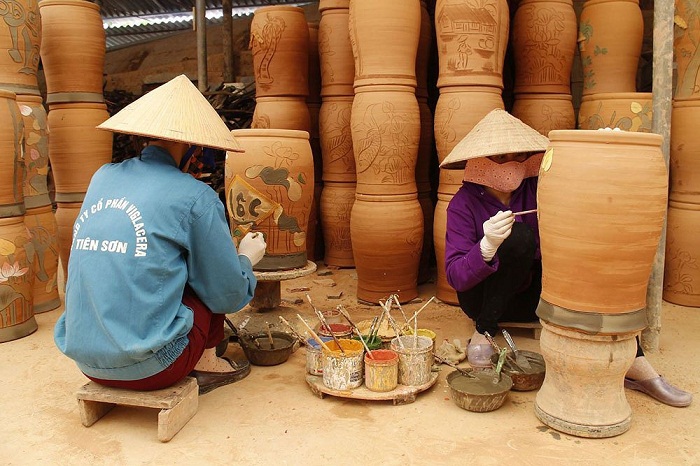 Artisans are decorating patterns on ceramic products
Artisans are decorating patterns on ceramic products
The raw material to create products of Phu Lang pottery village is light pink clay, undergoing many stages, the clay is finely tempered and then shaped on the turntable by the hands of a craftsman. Like many other traditional pottery villages such as Bat Trang (Gia Lam), Tho Ha (Viet Yen), the method of product shaping (with a circular cross section) is broaching. All products are put on the hand turntable, working around the turntable with 3 people, including one person who specializes in polishing, one person who rhymes the turntable, and one person running outside. For small sized products, 2 product creators are required: one sharpener and one rumbler.
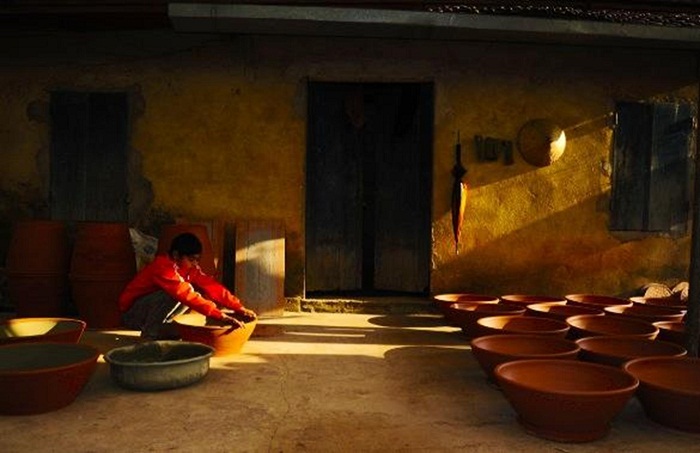 Ceramics are meticulously and carefully crafted by hand
Ceramics are meticulously and carefully crafted by hand
After the product has been shaped, let it shrink, until it is not sticky to the touch, then the worker will carry out a basket, punch, push the inside of the product to shape the object, let it dry. At this time, if there is a crack on the product, it will be patched with fine and crushed soil. The final step to complete the product is ticking, scraping. After that, the product is coated with a layer of enamel. Materials for making enamel include: forest ash, quicklime, crushed lime, white alluvial mud. These four ingredients, after preliminary processing, are mixed together in a certain ratio, and then processed into a liquid. When the product is still damp, the worker uses a bristle brush to brush the enamel on the outside of the product with an appropriate thin layer and then dry it. After enameling and drying, the products are milky white.
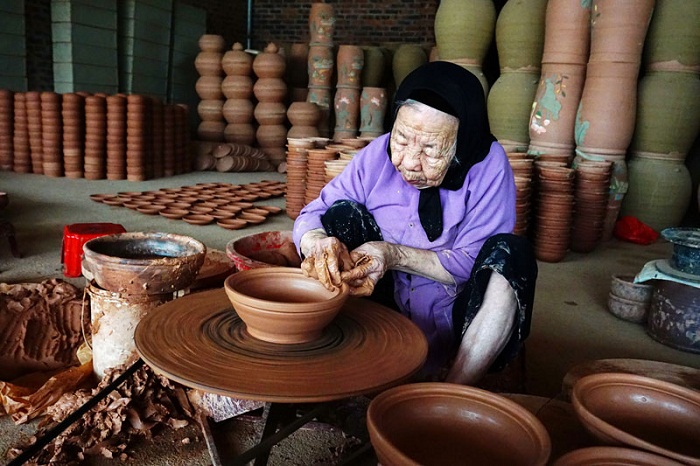 This is a very difficult step, so it requires a lot of experience
This is a very difficult step, so it requires a lot of experience
After being glazed and dried, the ceramics are stacked and put into the kiln. Stacking products in the kiln must follow the principle of maximizing the space of the kiln. To do that, the craftsman has to put the small pots in the big pots, the small ones are in the big ones… Just like that, the products are lined up to the top of the kiln. This arrangement has the effect that all voids in the oven are filled with product. Cooking time is 12 hours.
Discover the beauty of Phu Lang pottery village
Pottery products of Phu Lang village not only contribute a significant part to the economic development of the locality, but also contribute to the unique culture of Phu Lang.
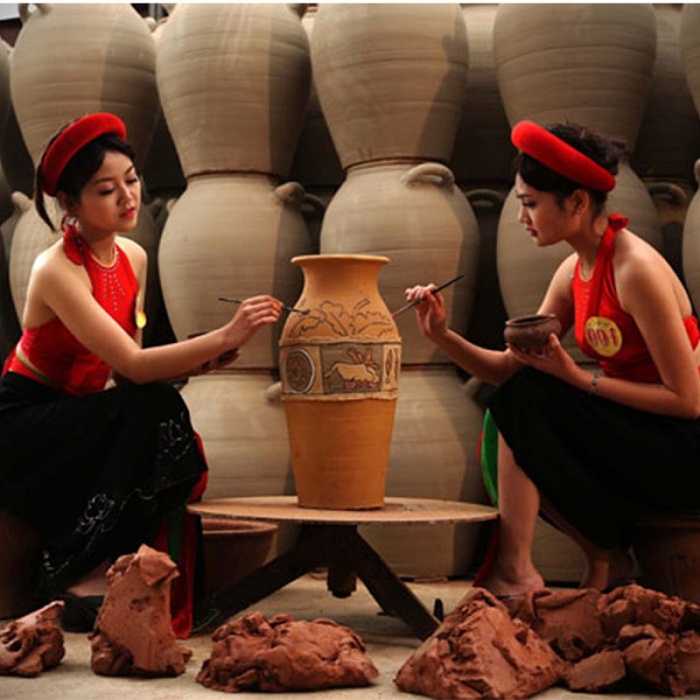 Phu Lang Pottery Village is an indispensable cultural beauty of the land of Quan Ho
Phu Lang Pottery Village is an indispensable cultural beauty of the land of Quan Ho
Unlike other pottery villages, Phu Lang ceramic products are covered with a layer of glaze with an eel skin pattern that looks both elegant and durable. In addition, the outstanding feature of Phu Lang pottery is the use of embossing method in the form of double-touch, natural, durable and strange enamel color; The shape of pottery is rustic but contains the pristine beauty of earth and fire, and is very bold in shape sculpture.
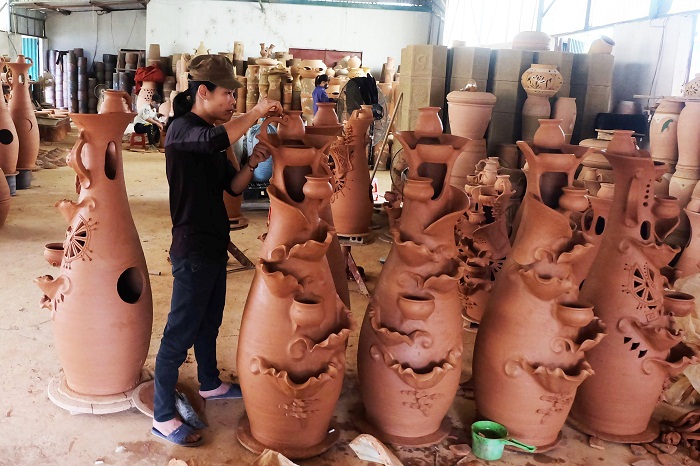 A unique and novel method to create extremely eye-catching ceramic products
A unique and novel method to create extremely eye-catching ceramic products
With love for the job, creativity, on the basis of tradition, they have painted a completely new look for traditional products by changing designs and adding decorative motifs and patterns on the products. There are many products to meet the different needs of users such as: lamps, vases, pedestals, reliefs, etc. In particular, decorative vases with a combination of ceramic and wood are very popular.
 Famous pottery paintings in Phu Lang village are handmade
Famous pottery paintings in Phu Lang village are handmadeA product you cannot ignore when coming to Phu Lang pottery village is the ceramic painting line. Thanks to the ingenuity, sophistication and meticulousness of potters, they have created extremely vivid paintings. In order to create a ceramic picture, it is necessary to go through many stages from the ground, shaping, cutting, drying, firing, painting… Particularly for ceramic paintings, it must be fired with a gas furnace for the earthen picture to “ripe” evenly. do not warp, warp, avoid dust, dirt or black burn.
 The meticulousness and sophistication of skilled craftsmen have created beautiful works
The meticulousness and sophistication of skilled craftsmen have created beautiful worksIt is a pity when you visit Phu Lang pottery village without buying yourself ceramic paintings to decorate your family space as well as as gifts for friends and relatives. Currently, the products of Phu Lang pottery village are not only appearing in the domestic market but also being exported to other countries such as the US, Japan, Korea… with rich and diverse products.
Source: Collected internet.